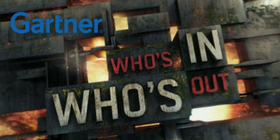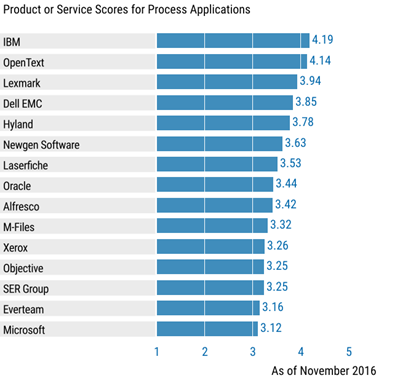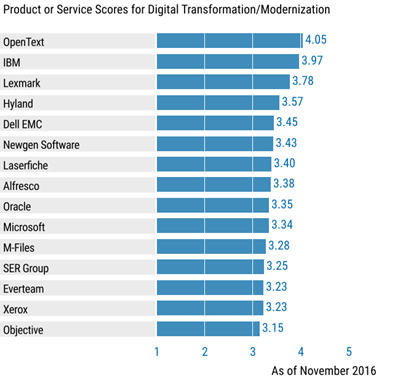Gartner Reveals Critical Capabilities for ECM
Last November, as you may recall, Gartner published its annual report, The Magic Quadrant for Enterprise  Content Management. Here, at CMS-connected, hot on the heels of the report, we discussed how much the little dots had migrated around and how Gartner made major changes to its inclusion criteria, resulting in the number of vendors included dropping from 20 in 2015 to 15 in 2016. To me, that report was unique in the space as it told so much about where the direction of the ECM market is heading and how ECM solutions are evolving to meet the needs of digital enterprises. But today we will discuss the Magic Quadrant’s companion report published by Gartner: Gartner’s Critical Capabilities for Enterprise Content Management. What is the difference between the two reports, you may ask. The best answer comes from the authors of the report, Karen M. Shegda and Gavin Tay:
Content Management. Here, at CMS-connected, hot on the heels of the report, we discussed how much the little dots had migrated around and how Gartner made major changes to its inclusion criteria, resulting in the number of vendors included dropping from 20 in 2015 to 15 in 2016. To me, that report was unique in the space as it told so much about where the direction of the ECM market is heading and how ECM solutions are evolving to meet the needs of digital enterprises. But today we will discuss the Magic Quadrant’s companion report published by Gartner: Gartner’s Critical Capabilities for Enterprise Content Management. What is the difference between the two reports, you may ask. The best answer comes from the authors of the report, Karen M. Shegda and Gavin Tay:
“The Magic Quadrant assesses the ECM vendors with respect to their ability to execute in the market and their vision. This Critical Capabilities document assesses the 15 vendors in terms of their ECM suites’ functional capabilities to support the following five use cases:
-
Personal and team productivity
-
Records management and compliance
-
Process applications
-
Content ecosystem
-
Digital transformation/modernization”
Therefore, I would like to take some time to discuss the state of these five use cases of assessment Gartner picked:
Personal and Team Productivity in the Digital Enterprise
Personal and team productivity is employees’ most valuable contribution to achieving the enterprise’s objectives. The emails, documents, spreadsheets, and presentations they create, share, and collaborate on simply presents the documented evidence of productivity and teamwork. So productivity is nothing new but what has changed is employees’ approach to productivity in the workplace. Therefore, enterprise content management systems should integrate seamlessly with other platforms that employees use to connect systems and individuals across the enterprise rather than taking content for granted through a one-way, dead-end repository. Although to do so sounds easy and makes total sense, it can get tricky, hence it is one the most lagging areas within a myriad volume of organizations as especially, personal productivity methods carry the highest risks to security, compliance, and privacy. The main goal here is providing ways to efficiently optimize productivity while controlling risk with necessary permissions.
If we paddle back to Gartner’s report, it is cited that the Alfresco One content management platform has evolved from its initial focus on repository services to becoming a solution for individual and team productivity, records management and compliance, and process applications. With Alfresco Share, the vendor supports content-centric collaboration, file sync and sharing which are key requirements for individual and team productivity, according to Gartner. On the other hand, the study found Dell EMC's Documentum family has been lagging behind other competitors in its ability to support personal and team productivity, as the vendor limits its capabilities by relying on integrations with Microsoft SharePoint and Syncplicity. The good news is, that the new Leap platform can change this for Dell EMC as it supports content sharing and external document exchange. In this functional area, Microsoft has been positioned as a Leader because SharePoint Server is widely deployed on-premises in enterprises to support personal and team productivity. Lastly, OpenText, which is ranked as the second vendor in this category, offers an ECM solution called OpenText Content Suite to provide a foundation for the Process Productivity, Personal Productivity, and Control the enterprise requires in a single suite—on-premise or in the cloud.
Records Management and Compliance in the Digital Enterprise
Supporting records management, regulatory compliance, and business continuity are one of the most fundamental features of any ECM suite, according to Gartner. Moreover, these ECM solutions also have to meet international standards and industry regulations like FDA, SEC, and HIPAA. Due to an ever-increasing amount of data, many organizations are struggling with these large volumes of documents, records, and data, as a result, many times data within organizations ends up being duplicated, out of date, inaccurate, or disconnected from current enterprise initiatives. It does not only diminish the productivity but also comes at a huge cost, especially when the lost document is required by tax authorities or regulatory agencies, or the content is needed as evidence in litigation.
In the report, Dell EMC is considered as well suited to the records management and compliance use case as the vendor offers support for regulations (FDA CFR 21: Part 11) and standards (ISO 9001), and comprehensive security and auditing. Other than Dell EMC, with Enterprise Records, IBM ECM solutions are also deployed to support records management and compliance use cases based on the report. However, the winner of this use case is OpenText as its Content Suite is certified for all the key industry standards for records management, including DoD 5015.2 v.3, VERS, and MoReq2010, and also supports ISO and FDA CFR 21: Part 11 regulations, according to Gartner. On the flip side, the report pointed out very interesting information about Microsoft, saying that although many organizations also have deployed SharePoint Server as a secure content repository, it actually lacks full records management and compliance with standards for records management and industry regulations.
Process applications in the Digital Enterprise
According to Karen M. Shegda and Gavin Tay of Gartner, “content and processes increasingly cross-company borders in uses such as fraud detection, collaborative decision making, deal rooms, merger and acquisition activities, and case management (legal, social services).” ECM solutions are now architected to meet consumer/user expectations at the edge because, today, enterprises need to ensure that its finance department can communicate seamlessly with HR, or their production departments should directly interact with the supply chain in real time. Therefore, ECM technologies are used to automate vertical business processes to diminish cycle times. Organizations are using these technologies also to support automating horizontal processes like accounts payable, invoice processing, case management, contracts management or correspondence management. Therefore, imaging, document management, integration with business applications such as ERP or CRM systems, and the ability to support multistep processes are more vital than ever before.
borders in uses such as fraud detection, collaborative decision making, deal rooms, merger and acquisition activities, and case management (legal, social services).” ECM solutions are now architected to meet consumer/user expectations at the edge because, today, enterprises need to ensure that its finance department can communicate seamlessly with HR, or their production departments should directly interact with the supply chain in real time. Therefore, ECM technologies are used to automate vertical business processes to diminish cycle times. Organizations are using these technologies also to support automating horizontal processes like accounts payable, invoice processing, case management, contracts management or correspondence management. Therefore, imaging, document management, integration with business applications such as ERP or CRM systems, and the ability to support multistep processes are more vital than ever before.
Then, how do the vendors respond to these ever-increasing demands in the market? Well, if we refer back to the report, the Documentum family is a solid option for process applications due to Dell EMC's historical strengths in document management and imaging, its business process management (BPM) and case management features, and its integration and interoperability capabilities, whereas SharePoint Server's lack of robust workflow and native document scanning software limits its suitability for structured process applications. Lexmark got a good score for this use case as it offers Perceptive Content for ECM needs around process applications such as patient records in healthcare, along with admissions, transcript processing and financial aid in higher education. Gartner gave Lexmark Enterprise Software a credit not only because of Perceptive Content but also because of other offerings in its portfolio like Kofax and ReadSoft, as they provide capture, recognition technologies and ERP integration capabilities that support financial process automation extremely well.
Since process applications are one of the core focuses of IBM's ECM portfolio, IBM Content Foundation and IBM Case Manager have been used to support a variety of industry-focused process solutions such as loan origination, claims processing and case management. The product has been positioned in first place in this particular category, in Gartner’s report. The Stamford, Conn.-based research firm also gave the vendor kudos due to the combination of IBM's content and predictive analytics capabilities and its integration strengths. Lastly, in this category, Hyland's integrations with line-of-business (LOB) applications such as Epic, Guidewire, and SAP received praise from the authors, as the platform enables users to view content in the context of their job roles.
Content Ecosystem in the Digital Enterprise
One of the key findings retrieved from the report is that the demand for transparent access to content, regardless of where it is stored and having the appropriate content surfaced in the context of the business task at hand while working in tools like Salesforce, SAP, Office 365, and Google has been significantly increased. Therefore, the report suggests that “the cross-repository search and access capabilities of insight engines, external document and file sharing, as well as integration and interoperability, are important functional requirements in supporting the content ecosystem.”
When it comes to the authors’ comments on the vendor for this use case, while Laserfiche ranks higher than many other vendors for the content ecosystem use case in the report, SharePoint has been considered weaker than many other providers for content ecosystem uses as it has limited integration with LOB applications outside of the Microsoft stack. Besides these, Lexmark has been chosen as suitable for content ecosystem uses as its Perceptive Content and Kofax TotalAgility have good integration with SAP and other horizontal and vertical LOB applications.
Digital Transformation/Modernization in the Digital Enterprise
 Today, business leaders are tasked to move their enterprises to the next level through digital transformation. According to analyst firm IDC, by the end of 2017, two-thirds of CEOs of Global 2000 companies will have digital transformation at the center of their corporate strategy. Another study that surveyed more than 700 global C-Level/VP decision makers also demonstrates that 86% say they have two years to make inroads before feeling the consequences, both in financial and competitive terms, while 55% say a year or less, and 59% are worried they may already be too late. Nevertheless, digital transformation involves different thinking, innovation, a modification in leadership & new business models and incorporating digital strategy into all aspects of the business to improve the experience of your organization’s employees, customers, suppliers, partners, and stakeholders. To do so, organizations need a good plan and the right technology in place. While traditional content management systems can help organizations get started on digital transformation, down the road they will need advanced and emerging content technologies such as content analytics, natural language generation, voice services and geolocation services to drive innovation, minimize their costs, and maximize the value of their enterprise content. According to Gartner, by 2019, the current enterprise content management market will devolve into cloud-based, content service platforms and purpose-built applications to enable enterprises to modernize their architecture and tools.
Today, business leaders are tasked to move their enterprises to the next level through digital transformation. According to analyst firm IDC, by the end of 2017, two-thirds of CEOs of Global 2000 companies will have digital transformation at the center of their corporate strategy. Another study that surveyed more than 700 global C-Level/VP decision makers also demonstrates that 86% say they have two years to make inroads before feeling the consequences, both in financial and competitive terms, while 55% say a year or less, and 59% are worried they may already be too late. Nevertheless, digital transformation involves different thinking, innovation, a modification in leadership & new business models and incorporating digital strategy into all aspects of the business to improve the experience of your organization’s employees, customers, suppliers, partners, and stakeholders. To do so, organizations need a good plan and the right technology in place. While traditional content management systems can help organizations get started on digital transformation, down the road they will need advanced and emerging content technologies such as content analytics, natural language generation, voice services and geolocation services to drive innovation, minimize their costs, and maximize the value of their enterprise content. According to Gartner, by 2019, the current enterprise content management market will devolve into cloud-based, content service platforms and purpose-built applications to enable enterprises to modernize their architecture and tools.
The five uses cases discussed in the report and in this article are essential, and critical, for enterprises to achieve their objectives. Therefore, the growth in the enterprise content management industry doesn’t seem to be impaired anytime soon. To me, it means that the opportunity lies therein for both enterprises and enterprise content management vendors. In today’s marketplace, if any organization aims at cultivating brand loyalty with today’s digitally-savvy and demanding customers, investing in these and other emerging technologies is certainly a smart move. If you want to set your business up to remain with or ahead of the curve over the next 5 to 10 years, feel free to go ahead and check out our other enterprise technology-related articles such as 6 Enterprise Tech Trend Predictions for 2017 and Beyond, What Will Drive the ECM Market in 2017, and Why Enterprises Struggle with IT Automation & Where to Begin.


Venus Tamturk
Venus is the Media Reporter for CMS-Connected, with one of her tasks to write thorough articles by creating the most up-to-date and engaging content using B2B digital marketing. She enjoys increasing brand equity and conversion through the strategic use of social media channels and integrated media marketing plans.